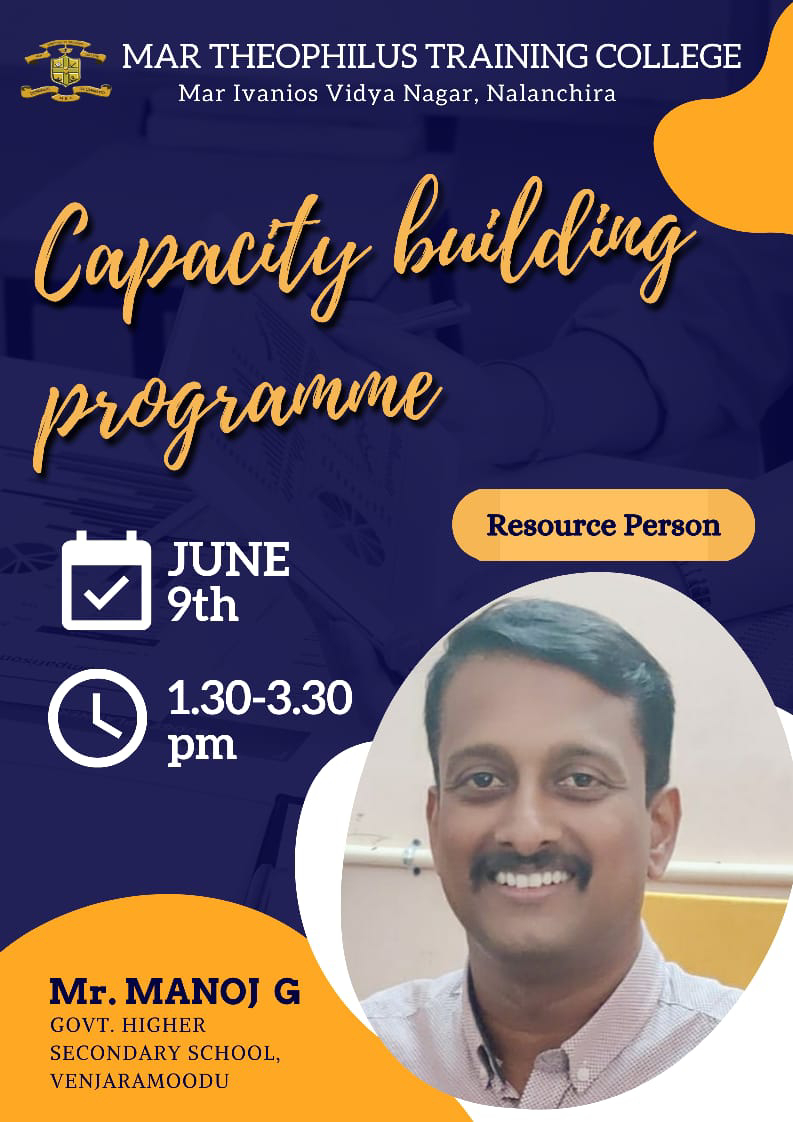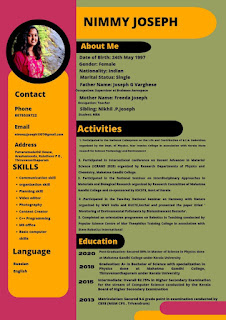Capacity building program
Capacity-building is defined as the process of developing and strengthening the skills, instincts, abilities, processes and resources that organizations and communities need to survive, adapt, and thrive in a fast-changing world.
The National Curriculum Framework (2009) has stated the need for comprehensive reforms in teacher education. There is a need to enhance the skills and capacity building in order to develop professionally .The inurgent and comprehensive reforms have been underlined as “ There is need to bring greater convergence between professional preparation and continuing professional development of teachers at all stages of schooling in terms of levels, duration and structure.” It also elaborates on the content, concerns and vision for teacher education.
Realizing the importance of professional development of teachers, the MBD Group has initiated steps to organize capacity building programs for teachers at all stages of school education – Pre- Primary, Primary, Upper- Primary , Secondary and Senior Secondary. The aim of the programme is to equip teachers in content and pedagogical competence such that they can seamlessly blend the same into classroom practices.
A capacity building program was organised by Mar Theophilus Training College Trivandrum on June 9th from 1.30 pm to 3.30 pm . The resource person was Mr. Manoj G.
He told the importance of having a specific goal and how not to get diverted from it. We should have strong determination and perseverance in achieving the goal, even if any situations comes that block our dreams. Our goal should be a attainable and realistic one. Our goal should be a SMART goal.
S- Specific
M- Measurable
A- attainable
R- Realistic
T- time Bound
SMART is a management term used to set goals. SMART is a mnemonic acronym, giving criteria to guide setting objectives, such as project management, employee performance management, and personal development.
The letters S and M generally mean specific and measurable. Possibly the most common version has the remaining letters referring to achievable, realistic, and timely.
Specific goals have a significantly greater chance of being accomplished. It stresses specifying a specific goal rather than a general one. A specific goal will usually answer the "Why", "What", "Who", "Which", and "Where" questions. You must consider these five questions to make a specific goal:
Who: Who is involved in this goal?
What: What do I want to accomplish?
Where: Where is this goal to be achieved?
When: When do I want to achieve this goal?
Why: Why do I want to achieve this goal?
A SMART goal must-have criteria for measuring progress. If there are no criteria, you will not determine your progress and if you are on track to reach your goal. To make a goal measurable, ask yourself these questions:
How many?
How much?
How do I know if I have reached my goal?
What is my indicator of progress?
A SMART goal must be achievable and attainable to be successful. It will help you figure out ways you can realize that goal and work towards it. The achievability of the goal should be stretched to make you feel challenged but defined well enough that you can achieve it. When you set an achievable goal, you may identify previously overlooked opportunities or resources to bring you closer to it. Ask yourself these questions:
Do I have the resources and capabilities to achieve the goal? If not, what am I missing?
Have others done it successfully before?
A SMART goal must be realistic in that the goal can be realistically achieved given the available resources and time. This step is about ensuring that your goal matters to you and aligns with other relevant goals. A SMART goal is likely realistic if you believe that it can be accomplished. Ask yourself these questions:
Is the goal realistic and within reach?
Is the goal reachable, given the time and resources?
Are you able to commit to achieving the goal?
A SMART goal must be time-bound in that it has a start and finish date. If the goal is not time-constrained, there will be no sense of urgency and less motivation to achieve the goal. Ask yourself these questions:
Does my goal have a deadline?
By when do you want to achieve your goal?
What can I do five months from now?
What can I do five weeks from now?
What can I do today?
Benefits of SMART-
SMART is an effective tool that provides the clarity, focus, and motivation you need to achieve your goals.
It can also improve your ability to reach them by encouraging you to define your objectives and set a completion date.
SMART goals are also easy to use by anyone, anywhere, without the need for specialist tools or training.
Inorder to achieve the goal , we should be hardworking .
Activity 1:
He gave us 10 statements and asked to get the signature of others who are appropriate for that.
1. I'm a good dancer
2. I am smart
3. My father is a teacher
4. I am hardworking
5. My sister is a student
6. I am sincere
7. I have a boyfriend
8. I always take initiative
9. I have a grandma at home
10. I always think positive
He selected 7 students who completed the activity within the stipulated time. And asked them to find the people who have signed in their book. He cross checked whether the people who have signed in the book lies or not. Then the people who signed were asked to come upon the stage. He instructed them to dance and they did it.
Inference:
Trust-
He asked whether anyone has signed by themselves. One student stood up and said she does. Actually he tried to convey that we should trust our potentialities.
ACTIVITY 2:
Then we were engaged with an activity. We were asked to draw maximum zeros within a certain time limit like around 30 seconds. He also asked us to set a goal like the number of zeros we can put in 30 seconds. After the activity we were asked to count the number of zeros and check whether we have reached the goal set earlier. At first we draw around 75 zeros maximum. We repeated the same activity and checked our ability to reach the fixed goal and above. From this we understood that we will be able to do more than we think. It's nothing but we have to step forward and we have to draw out our innate potentialities to achieve our goal. Only thing is that we should recognise our capacity and need to trust ourselves.
This time we were able to reach around 90 zeros. Now Manoj sir asked us to target around 130 zeros and that was too challenging for us this time. But Sir introduced us some strategies like to diminish the size of the zeros and there should be less spacing between the zeros. So again we repeated the same activity and saw wonders . Some of us were able to reach around 130 and more than that. Many of us draw more than hundred zeros. Here we achieved more than the target 🎯 which means in a life span we can do many things and we all have the potential to achieve it. To reach and lead a successful life we should change our thought process from 'no we can't ' to 'yes we can'. Inorder to reach success we should be sincere in our doings, even if it is small or big.
In the session , sir discussed about the suicidal tendencies in students.Although suicide is a rare event, it is the second leading cause of death among college students. Suicidal states are often associated with major depression, a combination of acute anxiety and depression, post traumatic stress disorder, and bipolar disorder. Suicidal people often tell people about their thoughts or give clues to others about their feelings.
Some factors associated with suicide risk are:
suicidal thoughts
pessimistic view of the future
intense feelings of hopelessness, especially when combined with anxiety
feelings of alienation and isolation
viewing death as a means of escape from
distress
personal or family history of depression or psychosis
personal or family history of suicide attempts
substance abuse
history of self- mutilation
The Role of the School in Suicide Prevention-
Children and adolescents spend a substantial part of their day in school under the supervision of school personnel. Effective suicide and violence prevention is integrated with supportive mental health services, engages the entire school community, and is imbedded in a positive school climate through student behavioral expectations and a caring and trusting student/adult relationship. Therefore, it is crucial for all school staff members to be familiar with, and watchful for, risk factors and warning signs of suicidal behavior. The entire school staff should work to create an environment where students feel safe sharing such information. School psychologists and other crisis response team personnel, including the school counselor and school administrator, are trained to intervene when a student is identified at risk for suicide. These individuals conduct suicide risk assessment, warn/inform parents, provide recommendations and referrals to community services, and often provide follow up counseling and support at school.
The child should give importance to his own life, he should value his life.
He quoted Abdul Kalam words, " The best brains of the nation may be found on the last benches of the classroom."
Activity 3:
In the session, shown us a short film "The Tree".
On a busy street in one of India's congested cities, traffic has ground to a halt.
Frustrations are high as a young man yells at a hapless policeman. A large tree has fallen across the narrow thoroughfare, and nobody knows what to do.
Snarled traffic, glum looks, despairing gridlock. A young woman says in English on her cell phone, "I hate this country."
Then the situation gets worse: it begins to rain. Buckets.
A young boy, maybe seven or eight, pokes his head out a bus window. His expression is serious. He walks to the tree, backpack over his shoulder, surveying the impossible barrier.
The boy drops his backpack and then leans his full 30 kilos of body weight into the many tons of tree trunk — water cascading off his nose and hair as he strains with all his might against the unmoving obstacle.
People begin to notice. A few other boys join the game, laughing as they push in vain against the huge log. Adults begin to see their effort, and one by one, they come alongside. Soon, there is an army of monsoon-soaked citizens, and they have become a team.
The group reaches critical mass and is able to lift the tree, pivoting its incredible mass to the side of the road. Then, from down a side street, you see traffic moving again.
The vignette ends with the team celebrating its sloshy victory with high-fives and cheers, including the young boy, who is shown slipping back into his backpack with a supremely satisfied grin on his face. We did it!
"The Tree" was a 2007 ad in India for a televised contest/reality show called "Lead India."
Inference:
Cooperation is powerful-
One boy can't move a tree, but there is a critical mass that occurs when enough people begin to lift — and the roadblock is removed.
God has revealed again and again in Scripture the power of unity and cooperation. "One can chase a thousand; two can chase ten thousand." "Two are better than one, because they have a better return for their labor...a three-fold cord is not easily broken."
With roughly 32 million teenagers in this country, the vision of reaching them with the gospel — let alone discipling and equipping them to reach the world — is daunting. Encouraging leaders to work together is a central way to accomplish that mission. Encouraging them to not give up is also hard-wired into Network's DNA.
Hence teamwork can also lead us to achieve the goal.
Activity 4:
The Story of Two Shoe Salesmen in Africa-
Once upon a time, a shoe company sent two salesmen to Africa to determine the market potential for their products. One salesman was sent to the east coast of Africa, while the other salesman was sent to the west coast of Africa. Both the salesmen completed a basic survey of the target market and called back to the office. The salesman sent to the east coast of Africa reported: “No one here wears any shoes, there is no market for us here!”. The other salesman sent a message “No one here wears any shoes, there is a huge market for us, send inventory fast!”.
Inference:
The point of the story is that your perspective influences your behaviour. Meaning, if you feel you cannot change a situation, you act one way. On the other hand, if you see the world as a place full of opportunities, you act differently.
Activity 5:
Shown a video on Derek Redmond's Emotional Olympic Story - Injury Mid-Race.
Derek Redmond was in fine form by the Barcelona Olympics. He achieved the fastest time of the first round, and won his quarter-final.
In the semi-final, Redmond also started well, but as he hit the back straight about 250 metres from the finish, his hamstring suddenly tore.
Redmond hobbled before stopping and falling to the ground in pain.
Stretchers were brought over to him, but Redmond decided he wanted to finish the race. After hobbling along the track, he was quickly joined on the track by his father, Jim Redmond.
Jim had barged past security to get to his son, who at first thought were officials trying to stop him.
In an act of brave defiance, Jim and Derek completed the lap of the track together, with Derek leaning on his father's shoulder to help him.
As they finished the finish line, 65,000 people gave them both a standing ovation.
Sadly, as his father had helped him finish, rules stated that Derek was officially disqualified, with Olympic records stating that he 'Did Not Finish' the race.
Inference:
A vision of courage-
"Strength is measured in pounds. Speed is measured in seconds. Courage? You can't measure courage"
He knew his dream was over. However, that didn’t deter his desire to complete the race. Instead of waiting for the medical officials to take him off the track, Redmond gathered the courage to get up. He started hobbling towards the finish line amid the pain of a torn hamstring, fighting back tears.











Comments
Post a Comment